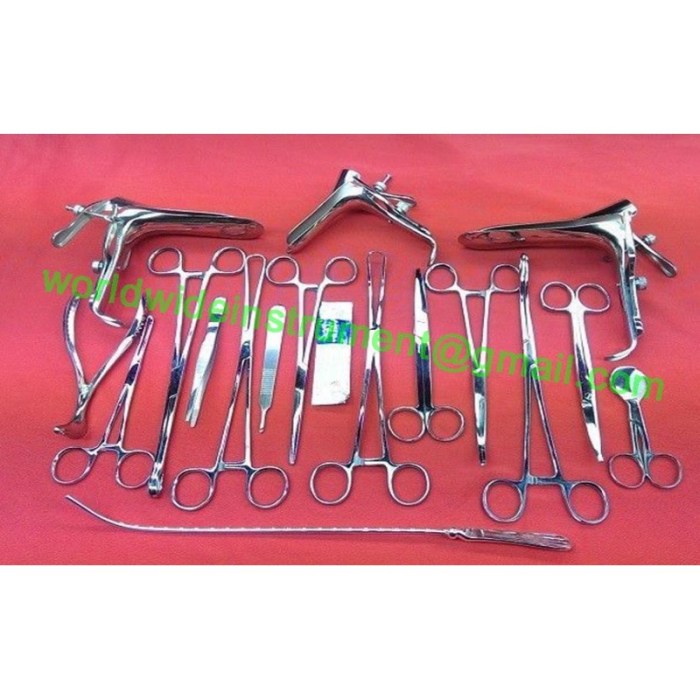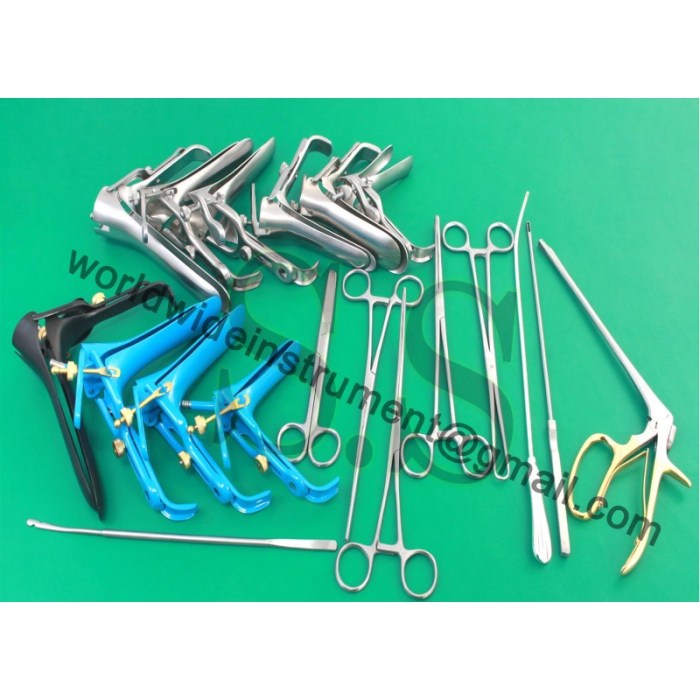Instruments used for gynecological examinations play a crucial role in the diagnosis and treatment of various gynecological conditions. From speculums to laparoscopes, these instruments provide healthcare professionals with the necessary tools to visualize, manipulate, and sample the female reproductive system.
This comprehensive guide will delve into the different types of instruments used in gynecological examinations, their indications, techniques, and potential risks. By understanding the purpose and proper use of these instruments, healthcare professionals can enhance the accuracy and effectiveness of gynecological care.
Instruments Used for Gynecological Examination

Gynecological examinations involve the use of specialized instruments to visualize, diagnose, and treat conditions of the female reproductive system. These instruments play a crucial role in providing accurate diagnoses and effective interventions, ensuring the well-being of women’s reproductive health.
Speculums, Instruments used for gynecological examination
Speculums are instruments used to widen the vaginal opening and expose the cervix for examination. They come in various types:
- Graves speculum:A large, duck-bill shaped speculum used for general examinations.
- Pederson speculum:A smaller, bivalve speculum used for virginal examinations or in cases of vaginal stenosis.
- Sim’s speculum:A single-blade speculum used for lateral visualization of the vagina and cervix.
- Cusco speculum:A bivalve speculum with wide blades used for examinations and procedures requiring maximum exposure.
Speculums are typically made of stainless steel or plastic and are inserted and removed using a twisting motion.
Dilators
Dilators are instruments used to gradually widen the cervical canal, allowing for the insertion of other instruments or procedures.
- Hegar dilators:Thin, graduated rods with rounded ends used for gradual dilation.
- Pratt dilators:Similar to Hegar dilators but with a larger diameter and a more pointed tip for easier insertion.
- Laminaria tents:Expandable, hygroscopic sticks made from seaweed used for cervical dilation before procedures like hysteroscopy or curettage.
Dilators are indicated for procedures such as intrauterine device (IUD) insertion, endometrial biopsy, and cervical conization.
Uterine Probes
Uterine probes are thin, flexible instruments used to measure the depth and direction of the uterine cavity.
- Sims uterine probe:A graduated probe with a blunt tip used for general uterine sounding.
- Uterine sound:A hollow probe with a sharp tip used for measuring the uterine cavity and detecting abnormalities.
- Endometrial sampling probe:A thin, flexible probe with a brush or curette at the tip used for endometrial biopsy.
Uterine probes are used to assess uterine size, shape, and patency, and to diagnose conditions such as uterine fibroids or endometrial hyperplasia.
Biopsy Instruments
Biopsy instruments are used to obtain tissue samples from the cervix, uterus, or other reproductive organs for pathological examination.
- Cervical biopsy forceps:Small, alligator-like forceps used to obtain cervical biopsies.
- Endometrial biopsy forceps:Small, spoon-shaped forceps used to obtain endometrial biopsies.
- Colposcopy biopsy punch:A small, circular punch used to obtain biopsies during colposcopy.
- Hysteroscopy biopsy forceps:Small, cup-shaped forceps used to obtain biopsies during hysteroscopy.
Biopsies are indicated for diagnosing conditions such as cervical cancer, endometrial hyperplasia, and uterine polyps.
Quick FAQs
What are the different types of speculums used in gynecological examinations?
Speculums come in various types, including Graves, Pederson, Cusco, and Sims speculums. Each type is designed for specific purposes and patient anatomy.
What are the indications for using dilators in gynecological examinations?
Dilators are used to gradually dilate the cervix to facilitate procedures such as hysteroscopy, endometrial biopsy, and intrauterine device insertion.
How are uterine probes used in gynecological examinations?
Uterine probes are used to measure the depth and direction of the uterine cavity, assess its patency, and detect any abnormalities.
What are the different types of biopsy instruments used in gynecological examinations?
Biopsy instruments include punch biopsy forceps, endocervical curettes, and endometrial sampling devices, each designed for obtaining tissue samples from different areas of the reproductive tract.


